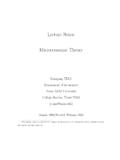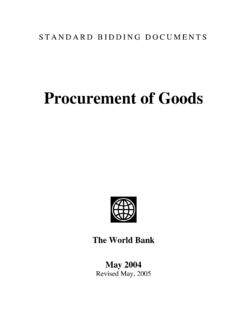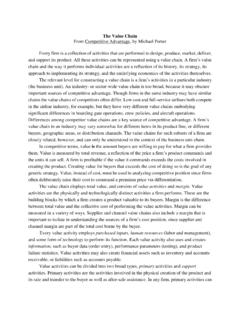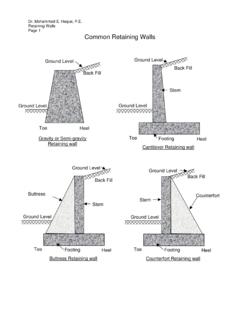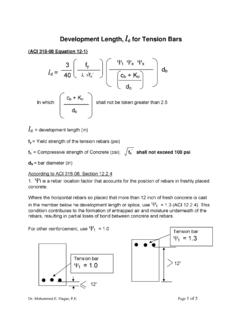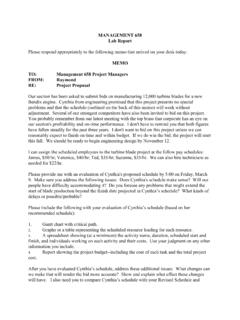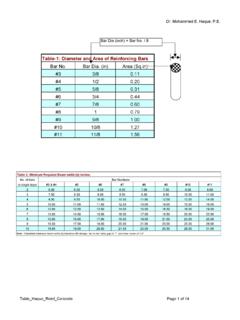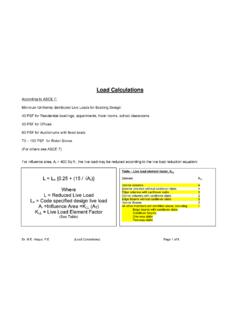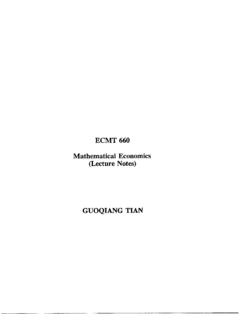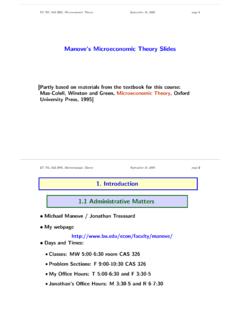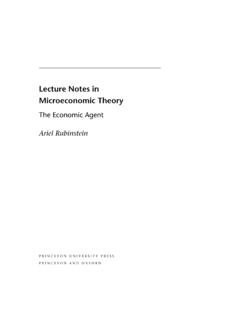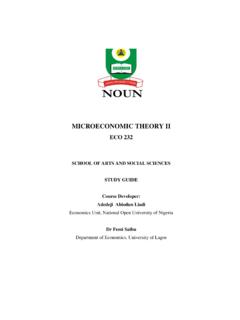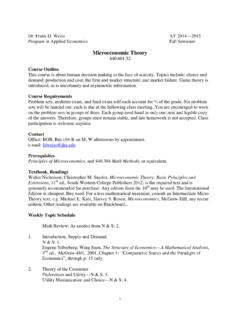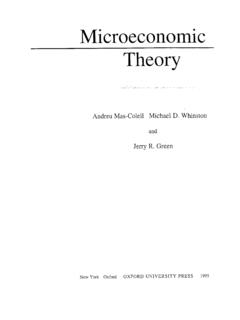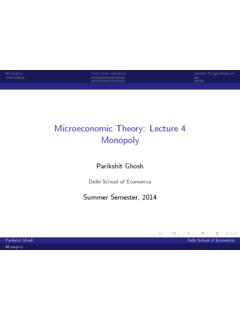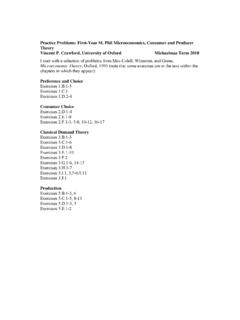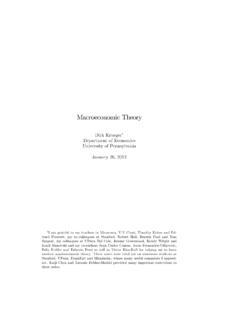Transcription of Lecture Notes Microeconomic Theory - …
1 Lecture Notes 1. Microeconomic Theory Guoqiang TIAN. Department of Economics Texas A&M University College Station, Texas 77843. August, 2002/Revised: January 2018. 1. This Lecture Notes are for the purpose of my teaching and convenience of my students in class. Contents 1 Preliminaries on Modern Economics and Mathematics 1. Nature of Modern Economics .. 2. Modern Economics and Economic Theory .. 2. Modern Economics and Modern Market System Governance 5. Modern Economics and Ancient Chinese Economic Thought 16. The Most Basic Assumption in Modern Economics .. 20. Other Assumptions Usually adopted in Economics .. 23. A Proper Understanding of Modern Economics .. 32. Basic Analytical Framework of Modern Economics .. 34. Basic Research Methodologies in Modern Economics .. 45. Basic Requirements for Understanding Modern Economic Theory .. 53. Roles of Modern Economic Theory .. 54. Some Remarks on Modern Economic Theory .. 55. Distinguishing Su cient and Necessary Conditions.
2 60. The Role of Mathematics in Modern Economics .. 61. Conversion between Economic and Mathematical Language 65. Language and Methods of Mathematics .. 66. Functions .. 66. Separating Hyperplane Theorem .. 68. i Concave and Convex Functions .. 69. Optimization .. 71. The Envelope Theorem .. 75. Point-to-Set Mappings .. 76. Continuity of a Maximum .. 82. Fixed Point Theorems .. 82. Continuous Distributions .. 84. Hazard Rates .. 85. Stochastic Dominance .. 86. Hazard Rate Dominance .. 91. Reverse Hazard Rate Dominance .. 91. Order Statistics .. 92. A liation .. 93. I Individual Decision Making 102. 2 Consumer Theory 104. Introduction .. 104. Consumption Set and Budget Constraint .. 105. Consumption Set .. 105. Budget Constraint .. 106. Preferences and Utility .. 107. Preferences .. 107. The Utility Function .. 113. Utility Maximization and Optimal Choice .. 119. Consumer Behavior: Utility Maximization .. 119. Consumer's Optimal Choice .. 119. Consumer's First Order-Conditions.
3 121. ii Su ciency of Consumer's First-Order Conditions .. 124. Indirect Utility, and Expenditure, and Money Metric Utility Func- tions .. 129. The Indirect Utility Function .. 129. The Expenditure Function and Hicksian Demand .. 131. The Money Metric Utility Functions .. 135. Some Important Identities .. 138. Duality Between Direct and Indirect Utility .. 142. Properties of Consumer Demand .. 145. Income Changes and Consumption Choice .. 145. Price Changes and Consumption Choice .. 145. Income-Substitution E ect: The Slutsky Equation .. 146. Continuity and Di erentiability of Demand Functions .. 150. Inverse Demand Functions .. 151. The Integrability Problem .. 153. Revealed Preference .. 156. Axioms of Revealed Preferences .. 156. Characterization of Revealed Preference Maximization .. 159. Recoverability .. 161. Topics in Demand Behavior .. 164. Endowments in the Budget Constraint .. 164. Income-Leisure Choice Model .. 165. Homothetic Utility Functions .. 166. Aggregating Across Goods.
4 167. Aggregating Across Consumers .. 173. 3 Production Theory 180. Introduction .. 180. Production Technology .. 181. iii Measurement of Inputs and Outputs .. 181. Speci cation of Technology .. 182. Common Properties of Production Sets .. 185. Returns to Scale .. 188. The Marginal Rate of Technical Substitution .. 190. The Elasticity of Substitution .. 190. Pro t Maximization .. 192. Producer Behavior .. 192. Producer's Optimal Choice .. 194. Producer's First-Order Conditions .. 195. Su ciency of Producer's First-Order Condition .. 197. Properties of Net Supply Functions .. 199. Weak Axiom of Pro t Maximization .. 200. Recoverability .. 202. Pro t Function .. 204. Properties of the Pro t Function .. 204. Deriving Net Supply Functions from Pro t Function .. 206. Cost Minimization .. 207. First-Order Conditions of Cost Minimization .. 208. Su ciency of First-Order Conditions for Cost Minimization 210. Cost Functions .. 214. Properties of Cost Functions .. 215. Properties of Conditional Input Demand.
5 216. Average and Marginal Costs .. 217. The Geometry of Costs .. 219. Long-Run and Short-Run Cost Curves .. 221. Duality in Production .. 222. Recovering a Production Set from a Cost Function .. 223. iv Characterization of Cost Functions .. 227. The Integrability for Cost Functions .. 229. 4 Choice Under Uncertainty 232. Introduction .. 232. Expected Utility Theory .. 233. Lotteries .. 233. Expected Utility .. 235. Uniqueness of the Expected Utility Function .. 237. Other Notations for Expected Utility .. 238. Risk aversion .. 239. Absolute Risk Aversion .. 239. Global Risk Aversion .. 243. Relative Risk Aversion .. 247. State Dependent Utility .. 249. Subjective Probability Theory .. 250. II Strategic Behavior and Markets 256. 5 Game Theory 258. Introduction .. 258. Description of a game .. 259. Strategic Form .. 259. Solution Concepts .. 264. Mixed Strategies and Pure Strategies .. 264. Nash equilibrium .. 265. Dominant strategies .. 269. Repeated games .. 270. Re nements of Nash equilibrium.
6 273. v Elimination of dominated strategies .. 273. Sequential Games and Subgame Perfect Equilibrium .. 274. Repeated games and subgame perfection .. 280. Games with incomplete information .. 282. Bayes-Nash Equilibrium .. 282. Discussion of Bayesian-Nash equilibrium .. 285. 6 Theory of the Market 288. Introduction .. 288. The Role of Prices .. 289. Perfect Competition .. 290. Assumptions on Competitive Market .. 290. The Competitive Firm .. 290. The Competitive Firm's Short-Run Supply Function .. 291. Partial Market Equilibrium .. 293. Competitive in the Long Run .. 295. Pure Monopoly .. 296. Pro t Maximization Problem of Monopolist .. 296. Ine ciency of Monopoly .. 299. Monopoly in the Long Run .. 300. Monopolistic Competition .. 301. Oligopoly .. 304. Cournot Oligopoly .. 304. Stackelberg Model .. 305. Bertrand Model .. 307. Collusion .. 309. Monopsony .. 310. vi III General Equilibrium Theory and Social Welfare 312. 7 Positive Theory of Equilibrium: Existence, Uniqueness, and Sta- bility 314.
7 Introduction .. 314. The Structure of General Equilibrium Model .. 317. Economic Environments .. 317. Institutional Arrangement: Private Market Mechanism .. 321. Individual Behavior Assumptions: .. 322. Competitive Equilibrium .. 322. Some Examples of GE Models: Graphical Treatment .. 326. Pure Exchange Economies .. 326. The Economy With One Consumer And One Producer/Robinson Crusoe Economy .. 334. Existence of Competitive Equilibrium .. 337. The Existence of CE for Aggregate Excess Demand Function338. The existence of CE under individual characteristics .. 345. Examples of Computing CE .. 355. The existence of CE for discontinuous demand function .. 360. Existence of CE for Aggregate Excess Demand Correspon- dences .. 367. Existence of CE for General Production Economies .. 369. The Existence of CE Under Non-Ordered Preference .. 372. Uniqueness of Competitive Equilibria .. 373. Stability of Competitive Equilibrium .. 378. Abstract Economy .. 386. Equilibrium in Abstract Economy.
8 386. Existence of Equilibrium for General Preferences .. 388. vii 8 Normative Theory of Equilibrium: Its Welfare Properties 395. Introduction .. 395. Pareto E ciency of Allocation .. 396. The First Fundamental Theorem of Welfare Economics .. 404. Calculations of Pareto Optimum by First-Order Conditions .. 411. Exchange Economies .. 412. Production Economies .. 413. The Second Fundamental Theorem of Welfare Economics .. 414. Non-Convex Production Technologies and Marginal Cost Pricing . 422. Pareto Optimality and Social Welfare Maximization .. 428. Social Welfare Maximization for Exchange Economies .. 429. Welfare Maximization in Production Economy .. 431. Political Overtones .. 433. 9 Economic Core, Fair Allocations, and Social Choice Theory 436. Introduction .. 436. The Core of Exchange Economies .. 437. Fairness of Allocation .. 444. Social Choice Theory .. 450. Introduction .. 450. Basic Settings .. 450. Arrow's Impossibility Theorem .. 453. Some Positive Result: Restricted Domain.
9 457. Gibbard-Satterthwaite Impossibility Theorem .. 459. 10 General Equilibrium Under Uncertainty 467. Introduction .. 467. A Market Economy with Contingent Commodities .. 468. Arrow-Debreu Equilibrium .. 473. viii Sequential Trade .. 476. Incomplete Markets .. 483. IV Externalities and Public Goods 488. 11 Externalities 491. Introduction .. 491. Consumption Externalities .. 492. Production Externality .. 501. Solutions to Externalities .. 503. Pigovian Tax .. 504. Coase' Voluntary Negotiation Property Rights Approach . 504. Missing Market .. 517. The Compensation Mechanism .. 518. 12 Public Goods 524. Introduction .. 524. Notations and Basic Settings .. 525. Discrete Public Goods .. 528. E cient Provision of Public Goods .. 528. Free-Rider Problem .. 529. Voting for a Discrete Public Good .. 531. Continuous Public Goods .. 532. E cient Provision of Public Goods .. 532. Lindahl Equilibrium .. 534. The First Fundamental Theorem .. 540. Core and Lindahl Equilibrium.
10 541. The Second Fundamental Theorem .. 542. Free-Rider Problem .. 545. ix V Information, Incentives, and Mechanism Design 551. 13 Optimal Mechanism Design: Contracts with One-Agent and Hid- den Information 558. Introduction .. 558. Basic Settings of Principal-Agent Model with Adverse Selection . 560. Economic Environment (Technology, Preferences, and In- formation) .. 560. Contracting Variables: Outcomes .. 560. Timing .. 561. Complete Information Optimal Contract(Benchmark) .. 561. First-Best Production Levels .. 561. Implementation of the First-Best .. 562. A Graphical Representation of the Complete Information Optimal Contract .. 564. Incentive Feasible Contracts .. 565. Incentive Compatibility and Participation .. 565. Special Cases .. 566. Monotonicity Constraints .. 567. Information Rents .. 568. The Optimization Program of the Principal .. 568. The Rent Extraction-E ciency Trade-O .. 570. The Optimal Contract Under Asymmetric Information .. 570. A Graphical Representation of the Second-Best Outcome.
